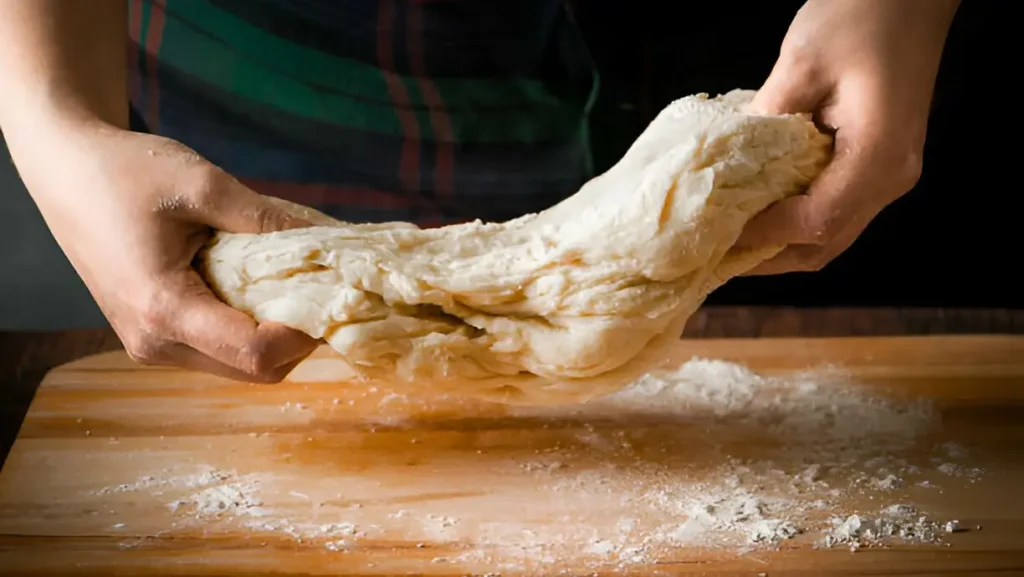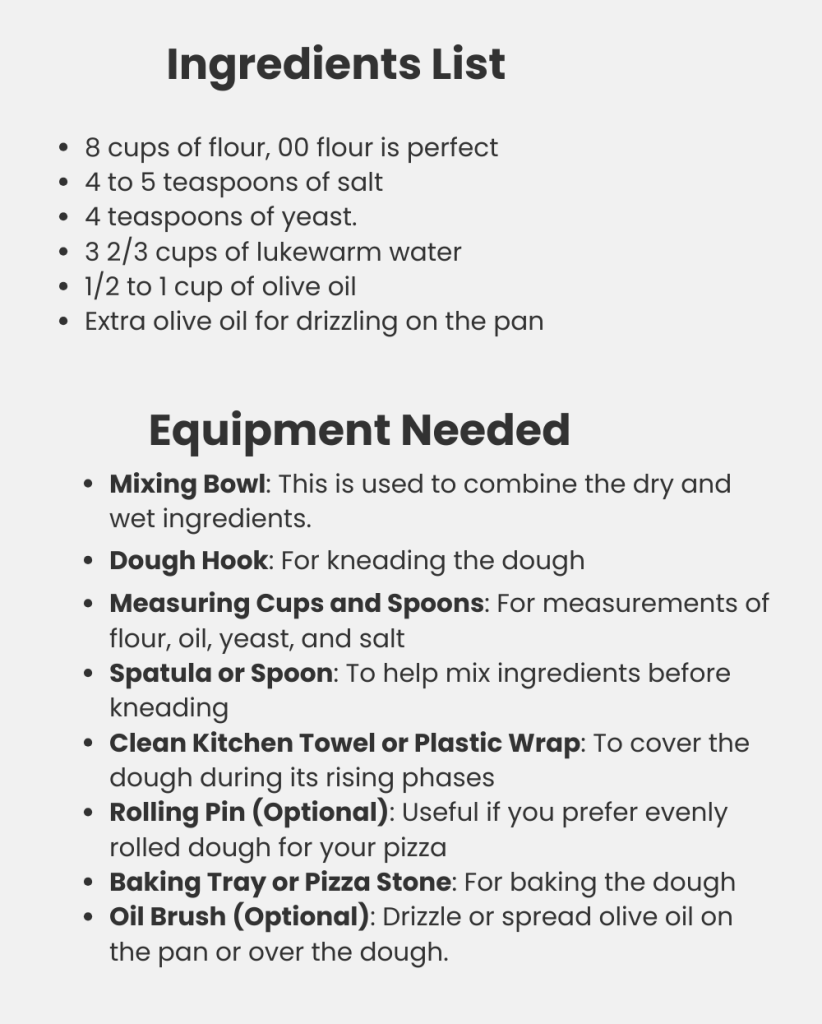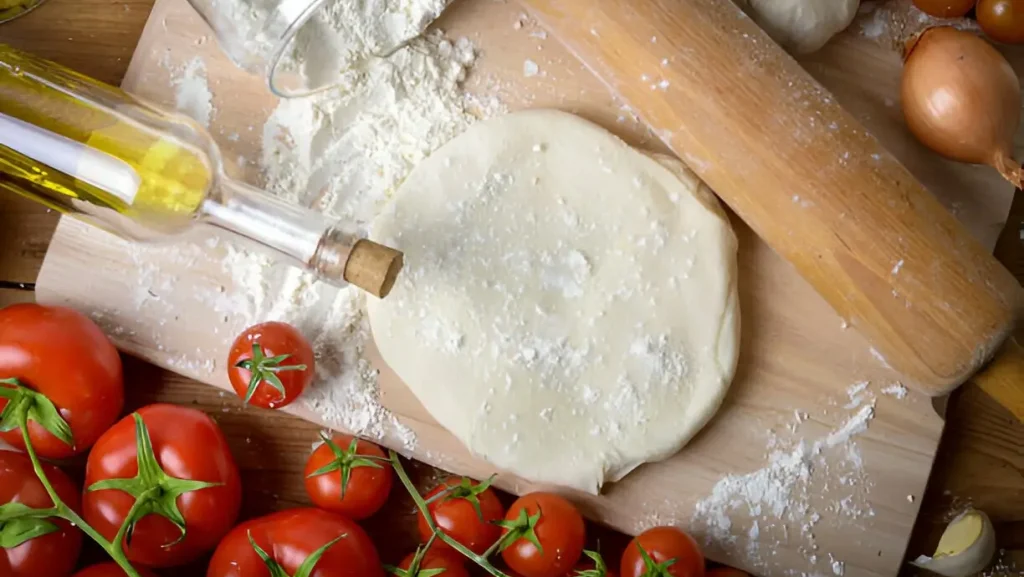Pizza is one of those dishes that is always a hit, no matter the occasion. It is easy to make and perfect for any occasion.
But if you are like me and love experimenting with new flavours, you will know that adding something extra can make all the difference. One of my favourite ways to upgrade pizza is by using olive oil in the dough.
Olive oil improves the flavor and helps create a soft, crispy crust that is hard to resist. The oil forms a layer that moisture, like that in tomato sauce, cannot easily pass through. So, olive oil in pizza dough stops sauce from soaking in and making it floppy.
Let’s learn how olive oil can make your pizza dough even more delicious!
Table of Contents
Olive Oil In Pizza Dough Or Not?
Adding olive oil to pizza dough makes it soft and easy to stretch. It gives the crust a crispy outside and a tender inside. It also prevents the sauce from soaking into the dough, keeping the crust firm.
Olive oil enhances flavor and texture, making the dough more flexible and helping achieve a crispier crust. As I noticed during my early experiments, skipping olive oil results in tougher dough and a less flavorful crust.
Depending on the pizza sizes you are preparing, I recommend adding 1 to 2 tablespoons of olive oil for every 2 to 3 cups of flour in pizza dough.
What Makes Olive Oil Pizza Dough Special?
Olive oil pizza dough is unique because it adds:
- Flavor: Olive oil adds a rich, fruity flavor that enhances the overall taste of the pizza.
- Elasticity: It makes the dough more elastic, which allows it to be stretched and shaped more easily.
- Crust: Olive oil helps to get a golden, crispy crust when baked, thus adding texture and crunch.
- Preservation: It also helps preserve the dough’s freshness, extend its shelf life, and keep it soft for longer.
How to Use Olive Oil with Pizza
When using olive oil in pizza dough, it’s essential to understand its effect on dough. Olive oil doesn’t change the dough’s hydration but adds flexibility and prevents the over development of gluten.

Most pizza dough recipes need 2 to 3 tablespoons of olive oil per 500 grams of flour, but you can adjust the amount based on your preference. Add oil to your dough ingredients and reduce the water slightly to maintain consistency.
Once the ingredients are combined, mix them by hand or with a stand mixer until dough forms. If the dough is too dry, add more water if it’s too wet, sprinkle in extra flour. The ideal dough should feel soft and smooth not sticky or dry.
Using the Right Amount
While adding olive oil is always a great idea, excess of everything is bad. You want to use the absolute correct amount to get the maximum out of your oil dough marriage.
For example, when I prepare Neapolitan style pizza dough, I use around 2 tablespoons of olive oil per 500 grams of flour, as this maintains the dough’s elasticity without overpowering the flavour. I use less oil for thin crust pizzas to keep the base light and crispy.
You can do that by looking at the nutritional content of the dough you make. Most recipes that require a unique type of dough will specify the nutrition content and how much oil to add, so you need not worry too much.When using the best pizza dough mixer, adding oil to the crust of your pizza dough becomes even easier.
Benefits Of Using Olive Oil In Pizza Dough
Best olive oil for pizza dough offers several advantages. It enhances the flavor and aroma, giving the dough a richer taste. The oil also improves the dough’s texture and makes it more elastic, which makes it easier to stretch and shape.
Additionally, it helps extend the dough’s shelf life and provides health benefits.
I. Enhanced Flavor and Aroma
Olive oil, especially extra virgin, improves pizza dough with a rich, aromatic taste that pairs perfectly with tomatoes, cheese, and herbs.
It gives the dough a mild, earthy flavor that feels authentic in homemade pizza. The olive oil creates a warm, inviting aroma as it bakes, elevating the pizza’s appeal.
II. Improved Texture
Olive oil significantly affects the texture of pizza dough. Its fat makes the dough more flexible and easier to stretch without tearing. When baked, it also helps create a softer and moister crust, improving the overall feel of the pizza.
The aroma of olive oil while baking adds an inviting warmth to your kitchen, and the golden crust it creates has a subtle, rich flavor that compliments every topping.
There is something satisfying about the smooth texture of the dough as you knead it, knowing the olive oil is working its magic. Professional bakers often point out that adding olive oil helps get the perfect chewiness and crispiness in the crust.
III. Better Dough Elasticity
One of the benefits of olive oil in pizza dough is that it improves elasticity. It makes the dough softer and more flexible, which helps it stretch easily without breaking or tearing.

This makes shaping the dough much simpler, whether by hand or with a rolling pin. The improved elasticity also allows the dough to rise evenly, resulting in a better texture for the final crust.
IV. Longer shelf life
Olive oil helps extend the shelf life of pizza dough by keeping it moist and preventing it from drying out. The oil creates a protective layer that reduces moisture loss and keeps the dough fresh for longer.
Therefore, you can store the dough for a few extra days without worrying about it becoming stiff or losing its quality.
V. Health benefits
Olive oil contains heart-friendly monounsaturated fats, which lower bad cholesterol (LDL) and raise good cholesterol (HDL). It is also rich in antioxidants like polyphenols and vitamin E, which reduce inflammation and protect against diseases.
Adding olive oil to pizza dough is an easy way to enjoy these health benefits while making your pizza delicious and nutritious.
Olive Oil Pizza Dough Recipe
Making olive oil pizza dough is simple. It is a quick process that results in a smooth, easy-to-work dough perfect for homemade pizzas. Follow the steps below to create a delicious base for your favorite toppings.

Step 1: Activate the Yeast
First, dissolve the yeast in lukewarm water and let it sit for a few minutes until frothy. This step ensures the yeast is active and ready to make the dough rise. The water should be warm but not hot, as extreme heat can harm the yeast.

Stir gently to mix the yeast with the water evenly. Once activated, the yeast creates the airiness needed for the dough.
Step 2: Mix Dry Ingredients
In a mixing bowl, combine the flour, salt, and yeast. Mix these dry ingredients thoroughly to distribute them evenly. Proper mixing ensures a uniform texture.
Salt enhances flavour and strengthens the dough. Blend everything well with a whisk or a spoon. This forms the base of the dough before adding any liquids.
Step 3: Combine Wet and Dry
Slowly add the activated yeast mixture and olive oil to the bowl with the dry ingredients. Use a spoon or mixer on low speed to combine the ingredients.
Mix until the dough starts to form and pulls away from the sides of the bowl. This step ensures the flour is mixed with the liquids. Once combined, the dough should be soft, slightly sticky, and ready for kneading.
Step 4: Initial Kneading
Attach a dough hook to your stand mixer and knead the dough on medium speed for 8–10 minutes. The hook will stretch and fold the dough to develop gluten. Gluten gives the dough strength and elasticity, making it easier to shape.
Whether you are preparing a classic or experimenting with a no-cheese pizza recipe, if the dough sticks to the bowl, sprinkle in more flour. Once kneaded, the dough should be smooth, soft, and slightly springy.
Step 5: First Rise
Transfer the kneaded dough to a lightly oiled bowl and cover it with a clean towel or plastic wrap. Place it in a warm spot and let it rise for 1–2 hours or until it doubles in size. During this time, the yeast creates air spaces, making the dough light and fluffy.
Step 6: Punch Down and Shape
After the dough has risen, gently punch it down to release air. Transfer it to a clean surface, divide it into portions if needed, and shape each into a ball or your preferred pizza base.

Handle gently to preserve the dough’s structure from the first rise, ensuring it’s ready for the final rise and baking.
Step 7: Final Rise
The shaped dough rests on the counter, covered with a clean towel. This allows the dough to relax and puff up slightly, making it easier to handle and stretch when baking.
During this time, you can prepare your toppings and preheat the oven. The final rise ensures the dough is light, airy, and ready to become the perfect pizza crust.
Olive Oil Substitute For Pizza Dough
Following are some substitutes for olive oil in pizza dough:

- Vegetable Oil: Vegetable oil is a simple substitute for olive oil in pizza dough. It keeps the dough moist but doesn’t add the rich flavor olive oil provides. The crust may also be less crisp, and the oil lacks the antioxidants found in olive oil.
- Canola Oil: Canola oil is another option with a mild taste that does not overpower the toppings. It creates a light and airy crust but might make the dough less tender. While it’s low in saturated fat, it doesn’t offer the antioxidants or richness of olive oil.
- Coconut Oil: Coconut oil adds a unique touch, especially unrefined, which gives a slight coconut flavor.
- Avocado Oil: Avocado oil gives the dough a mild, buttery flavor and a rich texture. Its high smoke point works well for pizzas baked at high heat, and it’s packed with vitamin E and lutein. The crust stays moist and chewy, similar to the results from olive oil.
Olive Oil Pizza Dough FAQs
How Much Olive Oil To Use?
The amount of olive oil typically ranges between 2% and 3% of the total weight of your flour, depending on the dough’s hydration level.
How Long Can I Store The Dough?
Olive oil pizza dough can be stored in the fridge for 2–3 days if kept in an airtight container to keep it fresh.
Why Isn’t My Dough Stretching Well?
If your olive oil pizza dough is not stretching, it might be too cold let it sit at room temperature for some time. It could also require more resting time to relax the gluten or cause an imbalance in hydration levels.
Conclusion
Adding olive oil to your pizza dough is an excellent way to ramp up the flavor of any pizza. It is easy to do and can be used in many ways.
- Adding oil makes the dough more flexible and allows it to be stretched without breaking easily.
- It adds nutrients not found in the traditionally made dough, hopefully leading to healthier pizzas.
- Adding oil to pizza dough allows for unique, impossible flavors with just flour and water.
We hope this article was informative and gave you insight into the pizza-making process.



